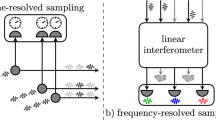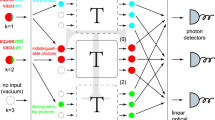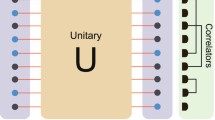Abstract
We give a full description of the problem of multi-boson correlation sampling (MBCS) at the output of a random interferometer for single input photons in arbitrary multi-mode pure states. The MBCS problem is the task of sampling at the interferometer output from the probability distribution associated with polarization- and time-resolved detections. We discuss the richness of the physics and the complexity of the MBCS problem for non-identical input photons. We also compare the MBCS problem with the standard boson sampling problem, where the input photons are assumed to be identical and the system is “classically” averaging over the detection times and polarizations.




Similar content being viewed by others
References
Aaronson, S., Arkhipov, A.: The computational complexity of linear optics. In: Proceedings of the 43rd Annual ACM Symposium on Theory of Computing, pp. 333–342. ACM (2011)
Alley, C.O., Shih, Y.H.: A new type of EPR experiment. In: Proceedings of the Second International Symposium on Foundations of Quantum Mechanics in the Light of New Technology, pp. 47–52. Physical Society of Japan, Tokyo (1986)
Bentivegna, M., Spagnolo, N., Vitelli, C., Flamini, F., Viggianiello, N., Latmiral, L., Mataloni, P., Brod, D.J., Galvão, E.F., Crespi, A., Ramponi, R., Osellame, R., Sciarrino, F.: Experimental scattershot boson sampling. Sci. Adv. 1(3), e1400255 (2015)
Broome, M.A., Fedrizzi, A., Rahimi-Keshari, S., Dove, J., Aaronson, S., Ralph, T.C., White, A.G.: Photonic boson sampling in a tunable circuit. Science 339(6121), 794–798 (2013)
Carolan, J., Meinecke, J.D.A., Shadbolt, P., Russell, N.J., Ismail, N., Wörhoff, K., Rudolph, T., Thompson, M.G., O’Brien, J.L., Matthews, J.C.F., Laing, A.: On the experimental verification of quantum complexity in linear optics. Nat. Photonics 8(8), 621–626 (2013)
Crespi, A., Osellame, R., Ramponi, R., Brod, D.J., Galvão, E.F., Spagnolo, N., Vitelli, C., Maiorino, E., Mataloni, P., Sciarrino, F.: Integrated multimode interferometers with arbitrary designs for photonic boson sampling. Nat. Photonics 7(7), 545–549 (2013)
Franson, J.D.: Beating classical computing without a quantum computer. Science 339(6121), 767–768 (2013)
Glauber, R.J.: Nobel lecture: one hundred years of light quanta. Rev. Mod. Phys. 78, 1267–1278 (2006)
Glauber, R.J.: Quantum Theory of Optical Coherence: Selected Papers and Lectures. Wiley-VCH, Weinheim (2007)
de Guise, H., Tan, S.H., Poulin, I.P., Sanders, B.C.: Coincidence landscapes for three-channel linear optical networks. Phys. Rev. A 89, 063819 (2014)
Hong, C., Ou, Z., Mandel, L.: Measurement of subpicosecond time intervals between two photons by interference. Phys. Rev. Lett. 59(18), 2044–2046 (1987)
Jerrum, M., Sinclair, A., Vigoda, E.: A polynomial-time approximation algorithm for the permanent of a matrix with nonnegative entries. J. ACM 51(4), 671–697 (2004)
Keller, M., Lange, B., Hayasaka, K., Lange, W., Walther, H.: Continuous generation of single photons with controlled waveform in an ion-trap cavity system. Nature 431(7012), 1075–1078 (2004)
Kolchin, P., Belthangady, C., Du, S., Yin, G.Y., Harris, S.E.: Electro-optic modulation of single photons. Phys. Rev. Lett. 101(10), 103601 (2008)
Laibacher, S., Tamma, V.: The physics and the computational complexity of multiboson correlation interference. arXiv:1507.01541 (2015)
Legero, T., Wilk, T., Hennrich, M., Rempe, G., Kuhn, A.: Quantum beat of two single photons. Phys. Rev. Lett. 93(7), 070503 (2004)
Loudon, R.: The Quantum Theory of Light. Oxford University Press, New York (2000)
Metcalf, B.J., Thomas-Peter, N., Spring, J.B., Kundys, D., Broome, M.A., Humphreys, P.C., Jin, X.M., Barbieri, M., Kolthammer, W.S., Gates, J.C., et al.: Multiphoton quantum interference in a multiport integrated photonic device. Nat. Commun. 4, 1356 (2013)
Minc, H.: Permanents, vol. 6. Cambridge University Press, Cambridge (1984)
Pan, J.W., Chen, Z.B., Lu, C.Y., Weinfurter, H., Zeilinger, A., Żukowski, M.: Multiphoton entanglement and interferometry. Rev. Mod. Phys. 84, 777–838 (2012)
Polycarpou, C., Cassemiro, K.N., Venturi, G., Zavatta, A., Bellini, M.: Adaptive detection of arbitrarily shaped ultrashort quantum light states. Phys. Rev. Lett. 109(5), 053602 (2012)
Ra, Y.S., Tichy, M.C., Lim, H.T., Kwon, O., Mintert, F., Buchleitner, A., Kim, Y.H.: Observation of detection-dependent multi-photon coherence times. Nat. Commun. 4, 2451 (2013)
Ralph, T.: Quantum computation: boson sampling on a chip. Nat. Photonics 7(7), 514–515 (2013)
Reck, M., Zeilinger, A., Bernstein, H.J., Bertani, P.: Experimental realization of any discrete unitary operator. Phys. Rev. Lett. 73, 58–61 (1994)
Rohde, P.P.: Boson sampling with photons of arbitrary spectral structure. Phys. Rev. A 91, 012307 (2015)
Shchesnovich, V.S.: Partial indistinguishability theory for multiphoton experiments in multiport devices. Phys. Rev. A 91, 013844 (2015)
Shen, C., Zhang, Z., Duan, L.M.: Scalable implementation of boson sampling with trapped ions. Phys. Rev. Lett. 112, 050504 (2014)
Shih, Y.H., Alley, C.O.: New type of Einstein–Podolsky–Rosen–Bohm experiment using pairs of light quanta produced by optical parametric down conversion. Phys. Rev. Lett. 61, 2921–2924 (1988)
Spagnolo, N., Vitelli, C., Bentivegna, M., Brod, D.J., Crespi, A., Flamini, F., Giacomini, S., Milani, G., Ramponi, R., Mataloni, P., Osellame, R., Galvao, E.F., Sciarrino, F.: Experimental validation of photonic boson sampling. Nat. Photonics 8(8), 615–620 (2014)
Spring, J.B., Metcalf, B.J., Humphreys, P.C., Kolthammer, W.S., Jin, X.M., Barbieri, M., Datta, A., Thomas-Peter, N., Langford, N.K., Kundys, D., et al.: Boson sampling on a photonic chip. Science 339(6121), 798–801 (2013)
Tamma, V.: Sampling of bosonic qubits. Int. J. Quantum Inf. 12, 1560017 (2014)
Tamma, V.: Analogue algorithm for parallel factorization of an exponential number of large integers I. theoretical description. arXiv:1505.04577 (2015). (t.b.p. in Quant. Inf. Proc.)
Tamma, V.: Analogue algorithm for parallel factorization of an exponential number of large integers II. optical implementation. arXiv:1505.04584 (2015). (t.b.p. in Quant. Inf. Proc.)
Tamma, V., Alley, C., Schleich, W., Shih, Y.: Prime number decomposition, the hyperbolic function and multi-path michelson interferometers. Found. Phys. 42(1), 111–121 (2012)
Tamma, V., Laibacher, S.: Multiboson correlation interferometry with multimode thermal sources. Phys. Rev. A 90, 063836 (2014)
Tamma, V., Laibacher, S.: Boson sampling with non-identical single photons. J. Mod. Opt. (2015). doi:10.1080/09500340.2015.1088096
Tamma, V., Laibacher, S.: Multiboson correlation interferometry with arbitrary single-photon pure states. Phys. Rev. Lett. 114, 243601 (2015)
Tamma, V., Nägele, F.: Correlation functions and matrix permanents. In: Proceedings of SPIE 8875, Quantum Communications and Quantum Imaging XI p. 88750F (2013)
Tamma, V., Zhang, H., He, X., Garuccio, A., Schleich, W.P., Shih, Y.: Factoring numbers with a single interferogram. Phys. Rev. A 83, 020304(R) (2011)
Tamma, V., Zhang, H., He, X., Garuccio, A., Shih, Y.: New factorization algorithm based on a continuous representation of truncated Gauss sums. J. Mod. Opt. 56(18–19), 2125–2132 (2009)
Tan, S.H., Gao, Y.Y., de Guise, H., Sanders, B.C.: SU(3) quantum interferometry with single-photon input pulses. Phys. Rev. Lett. 110, 113603 (2013)
Tichy, M.C.: Sampling of partially distinguishable bosons and the relation to the multidimensional permanent. Phys. Rev. A 91, 022316 (2015)
Tichy, M.C., Mayer, K., Buchleitner, A., Mølmer, K.: Stringent and efficient assessment of boson-sampling devices. Phys. Rev. Lett. 113, 020502 (2014)
Tillmann, M., Dakić, B., Heilmann, R., Nolte, S., Szameit, A., Walther, P.: Experimental boson sampling. Nat. Photonics 7(7), 540–544 (2013)
Tillmann, M., Tan, S.H., Stoeckl, S.E., Sanders, B.C., de Guise, H., Heilmann, R., Nolte, S., Szameit, A., Walther, P.: Generalized multi-photon quantum interference. arXiv:1403.3433 (2014)
Valiant, L.G.: The complexity of computing the permanent. Theor. Comput. Sci. 8(2), 189–201 (1979)
Yao, X.C., Wang, T.X., Xu, P., Lu, H., Pan, G.S., Bao, X.H., Peng, C.Z., Lu, C.Y., Chen, Y.A., Pan, J.W.: Observation of eight-photon entanglement. Nat. Photonics 6(4), 225–228 (2012)
Zhao, T.M., Zhang, H., Yang, J., Sang, Z.R., Jiang, X., Bao, X.H., Pan, J.W.: Entangling different-color photons via time-resolved measurement and active feed forward. Phys. Rev. Lett. 112, 103602 (2014)
Acknowledgments
V.T. is extremely glad to dedicate this work to the memory of Professor Howard Brandt. His enormous contribution to the field of quantum information is a treasure which will benefit science forever.
Funding V.T. acknowledges the support of the German Space Agency DLR with funds provided by the Federal Ministry of Economics and Technology (BMWi) under Grant No. DLR 50 WM 1556. This work was supported by a grant from the Ministry of Science, Research and the Arts of Baden-Württemberg (Az: 33-7533-30-10/19/2).
Author information
Authors and Affiliations
Corresponding author
Appendices
Appendix 1: Correlation functions as expectation values of permanents of operator matrices
We derive the expression in Eq. (8) of the correlation function \(G^{(\mathscr {D},\mathscr {S})}_{\{t_j,{\varvec{p}}_j\}}\) for multi-mode single-photon states. Inserting Eq. (5) into Eq. (6), we obtain
which, after interchanging the order of the product and the two summations, becomes
Here, the summation over the 2N indices \(\{i_j,i_j'\}_{j=1,\ldots ,N}\) covers all possible ways the N sources contribute to the product of 2N field operators in the expectation value in Eq. (6), independently of the input state.
Equation (27) can be simplified by recalling that the input state is the product of single-photon states in each of the input ports. Thus, since each source can at most contribute one photon, the expression \(\prod _{j=1}^N \big ( {\varvec{p}}_j \cdot {\hat{{\varvec{E}}}}^{(+)}_{i_j}(t_j-\Delta t) \big ) \vert {\mathscr {S}}\rangle \) is non-vanishing only if the indices \(i_j\ (j=1,\ldots ,N)\) take pairwise different values. Introducing the symmetric group \(\varSigma _N\) of all permutations \(\sigma \) of N elements, we find that in the non-vanishing cases, the indices take the values \(i_j = \sigma (j)\), with \(\sigma \in \varSigma _N\). The same argument can also be made for the possible values of the indices \(i_j'\). Therefore, the correlation function in Eq. (27) reduces to
which, with the definition of the operator matrix \({\hat{\mathscr {M}}}_{\{t_j,{\varvec{p}}_j\}}^{(\mathscr {D},\mathscr {S})}\) in Eq. (7), becomes
Appendix 2: Correlation functions for multi-mode single-photon states
We demonstrate here the expression for the correlation function for multi-mode single-photon states, found in Eq. (11). From the definition of the input state in Eq. (1), we find the expression
for the terms in Eq. (28). By using the definition of the single-photon states in Eq. (2) and the field operators
in the narrow bandwidth approximation, we obtain
In the narrow bandwidth approximation, we can approximately expand the integration over \(\omega \) to the complete real axis. By using the definition of a Fourier transform
we then find
By substituting this result together with Eq. (29), Eq. (28) reduces to the expression
in Eq. (11).
Appendix 3: Probabilities for non-resolved detections
1.1 Accounting for photon bunching
We now derive the probabilities (18) in the case of non-resolved detections in time and polarization. Toward this end, we have to take into account that the correlation function in Eq. (6) is symmetric under permutation of the arguments \(\{t_j,{\varvec{p}}_j\}\) and \(\{t_{j'},{\varvec{p}}_{j'}\}\) if both corresponding photons are detected in the same output port, i.e., if \(d_j = d_{j'}\).
For example, in the case of \(N=2\) and with both photons detected in the same output port d (\(\mathscr {D}=\{d,d\}\)), the correlation function
is symmetric with respect to the two possible detection times and respective polarizations \(\{t_1,{\varvec{p}}_1\}\) and \(\{t_2,{\varvec{p}}_2\}\): \(G^{(\{d,d\},\mathscr {S})}_{\{t_1,{\varvec{p}}_1;t_2,{\varvec{p}}_2\}} = G^{(\{d,d\},\mathscr {S})}_{\{t_2,{\varvec{p}}_2;t_1,{\varvec{p}}_1\}}\). This reflects the fact that both expressions describe the same probability rate of two photons being detected in the output port d, one at time \(t_1\) and with polarization \({\varvec{p}}_1\) and the other at time \(t_2\) and with polarization \({\varvec{p}}_2\).
Therefore, the corresponding probability
for non-resolved detections contains the additional factor 1 / 2! in order to avoid double counting.
Generalizing to the case of arbitrary samples \(\mathscr {D}\) in a 2M-port interferometer, where d is contained \(n_d\) times in \(\mathscr {D}\) (\(\sum _{d=1}^{M} n_d = N\)), we find the time- and polarization-averaged probabilities
in Eq. (18).
1.2 Integrated probabilities
We derive now Eq. (24) from the general expression of the probability \(P_{\text {av}}(\mathscr {D};\mathscr {S})\) in Eq. (18) for non-resolved detections. We first substitute in Eq. (18) the value for the correlation function in Eq. (30), yielding
With the substitution \(\sigma ' \rightarrow \rho \circ \sigma \), where \(\rho \in \varSigma _N\), Eq. (31) becomes
Here, the second product can be written as a product over \(i=\sigma (j)\) instead of j since \(\sigma \) is bijective, rendering this expression independent of the permutation \(\sigma \):
By using the definitions of \(f_{\rho }(\mathscr {S})\) and \(\mathscr {A}_{\rho }^{(\mathscr {D},\mathscr {S})}\) in Eqs. (20) and (23), Eq. (32) finally reduces to the expression
in Eq. (24).
Appendix 4: Two-photon indistinguishability factors for Gaussian spectral distributions
We derive the two-photon indistinguishability factors for Gaussian spectral distributions in Eq. (22). By inserting Eq. (21) into Eq. (19), we obtain the Gaussian integral
which, using the well-known relation \(\int \limits _{-\infty }^{\infty }dx \exp (-a x^2 + bx +c) = \sqrt{\pi /a} \,\exp (b^2/(4a) + c)\), can be evaluated as
Rights and permissions
About this article
Cite this article
Tamma, V., Laibacher, S. Multi-boson correlation sampling. Quantum Inf Process 15, 1241–1262 (2016). https://doi.org/10.1007/s11128-015-1177-8
Received:
Accepted:
Published:
Issue Date:
DOI: https://doi.org/10.1007/s11128-015-1177-8




